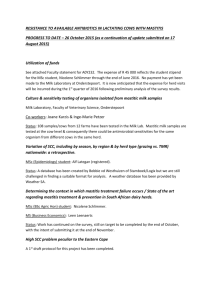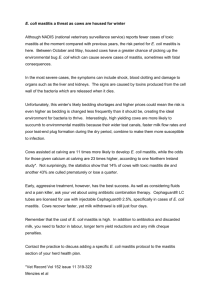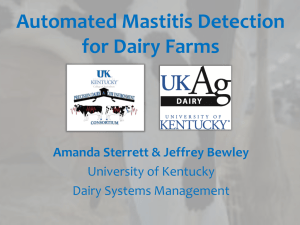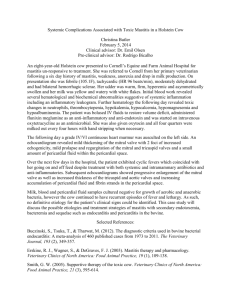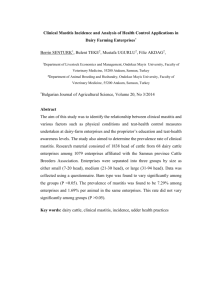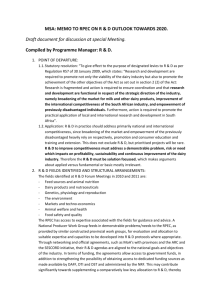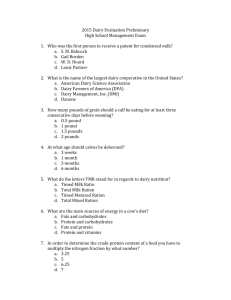economical losses from clinical mastitis in 4 dairy herds in israel
advertisement
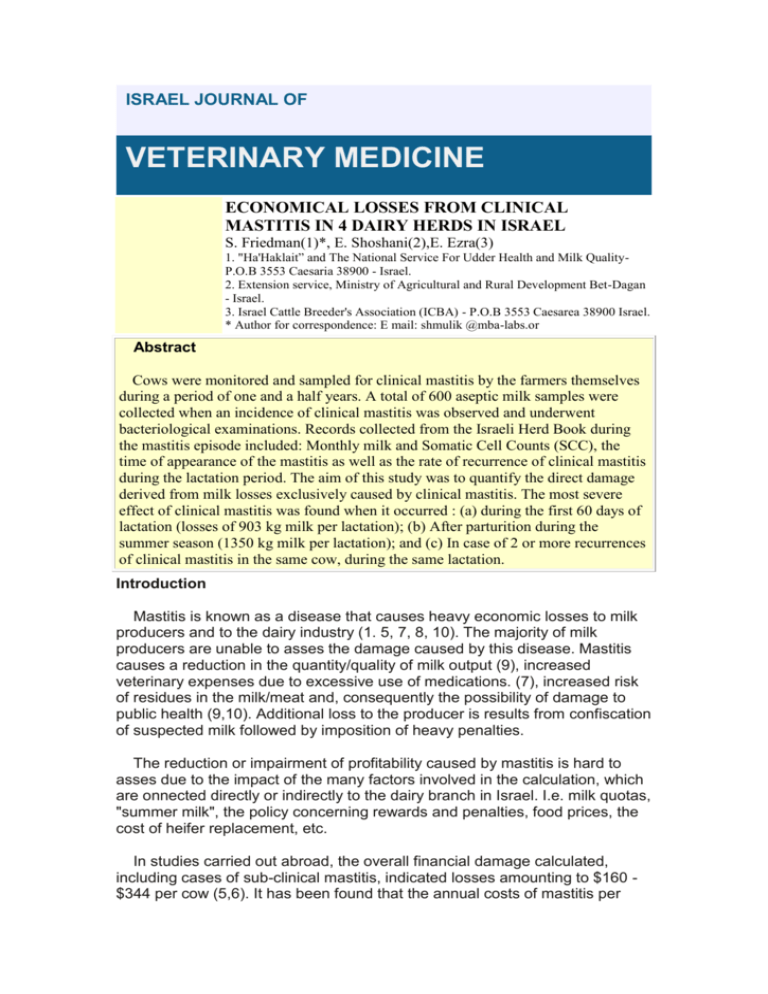
ISRAEL JOURNAL OF VETERINARY MEDICINE ECONOMICAL LOSSES FROM CLINICAL MASTITIS IN 4 DAIRY HERDS IN ISRAEL S. Friedman(1)*, E. Shoshani(2),E. Ezra(3) Vol. 59 (1-2) 2004 1. "Ha'Haklait” and The National Service For Udder Health and Milk QualityP.O.B 3553 Caesaria 38900 - Israel. 2. Extension service, Ministry of Agricultural and Rural Development Bet-Dagan - Israel. 3. Israel Cattle Breeder's Association (ICBA) - P.O.B 3553 Caesarea 38900 Israel. * Author for correspondence: E mail: shmulik @mba-labs.or Abstract Cows were monitored and sampled for clinical mastitis by the farmers themselves during a period of one and a half years. A total of 600 aseptic milk samples were collected when an incidence of clinical mastitis was observed and underwent bacteriological examinations. Records collected from the Israeli Herd Book during the mastitis episode included: Monthly milk and Somatic Cell Counts (SCC), the time of appearance of the mastitis as well as the rate of recurrence of clinical mastitis during the lactation period. The aim of this study was to quantify the direct damage derived from milk losses exclusively caused by clinical mastitis. The most severe effect of clinical mastitis was found when it occurred : (a) during the first 60 days of lactation (losses of 903 kg milk per lactation); (b) After parturition during the summer season (1350 kg milk per lactation); and (c) In case of 2 or more recurrences of clinical mastitis in the same cow, during the same lactation. Introduction Mastitis is known as a disease that causes heavy economic losses to milk producers and to the dairy industry (1. 5, 7, 8, 10). The majority of milk producers are unable to asses the damage caused by this disease. Mastitis causes a reduction in the quantity/quality of milk output (9), increased veterinary expenses due to excessive use of medications. (7), increased risk of residues in the milk/meat and, consequently the possibility of damage to public health (9,10). Additional loss to the producer is results from confiscation of suspected milk followed by imposition of heavy penalties. The reduction or impairment of profitability caused by mastitis is hard to asses due to the impact of the many factors involved in the calculation, which are onnected directly or indirectly to the dairy branch in Israel. I.e. milk quotas, "summer milk", the policy concerning rewards and penalties, food prices, the cost of heifer replacement, etc. In studies carried out abroad, the overall financial damage calculated, including cases of sub-clinical mastitis, indicated losses amounting to $160 $344 per cow (5,6). It has been found that the annual costs of mastitis per cow (irrespective of the severity of infection), were around $200-300 in the USA and France (1,2) and 120 £ in England (3). Forced culling of cows affected by mastitis results in decrease of infected cows and reduces the risk of infecting new members of the herd (7,8,9). Consequently, there is an immediate decrease in the overall milk production level with a direct impact on the dairy farmer's income (10). Despite the wide divergence between dairies, it showed that the average loss for one case of clinical mastitis was about $40 (4) . The cost of replacement of heifer varies among countries, and depends on the current market demands. This inflicts more financial damage. The aim of this study was to quantify the direct damage incurred by milk losses caused exclusively by clinical mastitis. Materials and Methods Cows (n = 970) from four farms (3 cooperative farms consisting of 300 cows/herd, and one familial farm with 100 cows milked twice a day), were monitored and sampled for clinical mastitis by the farmers for one and a half years (1998-9). The mean daily milk yield was 36.5 kg/cow in the cooperative farms and 31.9 kg/cow in the familial farm. The SCC annual averages in all farms where between 350.000 and 525.000 /ml milk . Postdipping (Iodophors of 4000 ppm of final concentration ,Zohar Dalia, Israel) and dry cow treatment (Nafpenzal DC, Intervet, Holland) where used in all the farms. Procedures for collection and diagnosis of milk samples were performed as described previously (11,12). A total of 600 aseptic milk samples were collected when an incidence of clinical mastitis was occurred (based on any observable signs in the udder and/or milk) and delivered to the national mastitis laboratory (Israeli Dairy Board, Caesaria) for bacteriological examination. A 0.01 ml' of milk was streaked on Tryptose Soy Agar ( TSA - Hylab Laboratories, Rehovot, Israel) containing 7.5% sheep blood and incubated for 48 h at 370C. (12). Concurrently with this procedure, records collected from the Israeli Herd Book during the mastitis episode included: Monthly milk and Somatic Cell Counts (SCC), the time of appearance of the mastitis as well as the rate of recurrence of clinical mastitis during the lactation period. The period of clinical mastitis was calculated as 40 days prior to the bacteriological findings of the udder infection and up to 20 days later (total of 60 days). Statistical analysis All data were analyzed by the GLM procedure of SAS (SAS 1990) by the following model: Y= µ+Hti + CDIMk+LL +DIM+Um +Sn+e Y= Milk production. µ= Overall mean. H= Herd effect CDIM= Category of day in milk (DIM) k=1,2,3 L= Lactation number L= 1,2,3,4+ Um=Udder Infection pathogen Sn = Calving season (1= winter, 2= summer) e = Error term Days in Milk (DIM) were divided to 3 categories - 0-60, 61-100 and 101-305 days. Due to small number of cows aged more than 4 lactations they were grouped to lactation 4. Results and Discussion Most of clinical mastitis in our study originated from environmental bacteria; Escherichia coli was the most dominant bacteria following by Coaguase Negative Staphylococci (CNS) (Table 1). The high rate of clinical mastitis, caused by environmental pathogens, might indicate that the sources of the infecting bacteria in Israeli dairy-farms could be attributed to barn maintenance. I.e.: untreated open farm yards (which are currently forbidden by law), unsuitable rest area (less than 15 m2/cow) and lack of hygienic treatment of the cow before milking. It should be emphasized, though, that there is a wide diversity amongst the farms involved in this study. Therefore, one should not conclude that the conditions in all dairy farms in Israel are similar. The diversity of the environmental bacteria, requires an individual approach to each farm. Examination of the occurrence of clinical mastitis showed that 25% of the infections appeared during the first 60 DIM, 13% between 61-100, and 62% after 101 DIM. Secretory tissue proliferation is the main factor to enhance milk production along the lactation curve (Wilde et al.,2000)/ Although the highest occurrence of clinical mastitis was found during the third phase of lactation, the greater financial loss occurred during the earlier phases due to interference of secretory tissue proliferation.. In our study the main damage to milk production was caused when the clinical mastitis occurred during the first phase of lactation - a loss of 903 kg milk per lactation (Table 2). Table 1. Distribution (%) of bacteriological diagnosis of clinical mastitis in 4 farms Sn= number of samples, (N= number of cows). Pathogenic factor E.coli CNS Streptococcus spp. Nocardia C. Bovis Others Farm 1; Farm 2; Farm 3; Farm 4; Sn=30 (N=70) Sn=277 (N=340) Sn=67 (N=270) Sn=132 (N=290) 60 20 7 0 0 13 45 17 13 2 7 7 80 6 8 0 0 2 64 4 8 6 0 3 Table 2. Mean milk yield per DIM of standardized lactation (305d) and SCC of cows, which were infected with clinical mastitis during one of three lactation stages. Mastitis event Category 1 (0-60) 2 (61-100) 3 ( >100) No mastitis in DIM Milk (Kg) 34.00 ± 1.5 35.83 ± 1.3 35.37 ± 1.6 36.96 ± 0.9 SCC (*1000) 670 ± 144 632 ± 227 456 ± 293 873 ± 44 Nocardia spp. Was found as the dominant bacteria causing milk loss while Escherichia coli, Corinobacterium bovis and CNS had similar effect. However, due to low number of infected cows, excluding E. coli (n=34, table 5), those figures should be considered cautiously. The damage of clinical mastitis, caused by E. coli, was expressed in 1.9 Kg milk loss per milking day and 580 Kg for the entire period of lactation (305 days). When the effect of the calving seasons was examined (Table 4), it was found that cows calving in summer (April-September) lost 1350 kg milk per lactation, when clinical incidents of mastitis developed during the first 60 days after parturition. In comparison to loss of 420 kg milk per lactation of cows calving in winter (October-may). It was found that 22% of the cows had two or more recurrences of mastitis during one lactation period, either with the same bacteria species or with a different one. A new or recurrent infection was defined when it appeared two or more times during the same lactation and when a clinical mastitis reappeared 20 days after the previous occurrence. E. coli was the dominant pathogen diagnosed more than once in the same lactation (table 5). Out of the "recurrent cows": 13% had mastitis three or more times during lactation. We hypothesize that there are few cows in each farm, which are more succeptible to environmental bacteria than others due to udder and teat structure or different heredity/immunity status. Culling of cows with recurrent clinical infections in the same lactation period, might reduce the financial loss at a later stage. Table 3. The effect of type of pathogen on milk yield per DIM during the period of clinical mastitis*. Type of pathogen Milk E.coli 32.7 ± 0.8 C. bovis 32.5 ± 2.4 Nocardia spp. 30.4 ± 1.9 Coagulase Negative 32.5 ± 1.2 Staphylococci (CNS) Strep. disgalactia 32.9 ± 1.6 No growth 34.5 ± 1.0 * a period of 40 days prior to bacteriologic result and 20 days after = a total of 60 days. Table 4. The effect of clinical mastitis event on milk yield and SCC by interaction between calving season and stage of lactation. Mastitis event in DIM Calving Season Category Milk SCC Winter (Oct - March) 1 (0-60) 35.9 ± 1.2 685 ± 158 2 (61-100) 36.7 ± 1.0 699 ± 161 3 (>100) 36.6 ± 1.0 396 ± 185 No mastitis* 37.3 ± 0.9 87 ± 47 Summer (April-Sept.) 1 (0-60) 32.1 ± 1.0 654 ± 185 2 (61-100) 35.0 ± 0.9 564 ± 183 3 (>100) 34.1 ± 1.1 516 ± 146 No mastitis* 36.6 ± 0.9 87 ± 67 * - cows in which clinical mastitis and SCC higher than 200,000 did not occur during the entire lactation period. Table 5. Recurrence rate of pathogen which caused clinical mastitis in a cow during a lactation period. Type of pathogen E.coli Serratia A. piogenes Nocardia spp. Staph. aureus CNS Strep. dysgalactia No. growth Others Total Recurrence rate in % 36.56 3.23 1.08 7.53 1.08 9.68 2.15 37.63 1.08 100 No. of cows 334 3 1 7 1 9 2 35 1 93 Conclusion The damages discussed in this paper refer only to milk loss. It does not include damages incurred by use of medications, extra work, disposal of milk, fines, death of cows, and the cost of replacing heifers. From a literature survey and results of another study we performed (in preparation), it was found that sub-clinical mastitis might cause a greater damage in terms of milk loss' compared to clinical mastitis' due to its high prevalence and duration. Although sub-clinical mastitis causes the greatest damage to milk producers (13), clinical mastitis is also a significant contributor. The most severe effect of clinical mastitis was found in our work, when it occurred (a) during the first 60 days of lactation; (b) after parturition during summer (1350 kg milk per lactation) and (c) when recurrences appeared more then twice during the same lactation. In order to minimize the damage from clinical and sub-clinical mastitis it is necessary to focus on preventive actions at the farm-medical level rather than to resort to syringe and antibiotics. Appropriate and continuous maintenance of the cows, housing, prevention of stress actions, and a fully hygienic milking routine will minimize the damage caused by clinical mastitis. Reference: 1. Seegers H., Fourichon C , Beaudeau F .Bareille N. :Mastitis control programmers and related costs in French dairy herds. 48th Annual meeting of the European association for animal production Vienna (Austria),1977. 2. Blowey, R.W :An assessment of the economic benefits of a mastitis control scheme. Veterinary Record 119.551-553,1986. 3. Fourichon, C, Horet. P, Seegers. H, Sorensen J.T. , Beaudeau F., :Assessments of economic efficiency of mastitis control programmed by simulation. 48th Annual meeting of the European association for animal production. Vienna (Austria), 1977. 4. Edmondson P, Blowey R,: Record analysis in mastitis investigation. In Practic June, 297-303,1998. 5. Morin De, Peterson GC, Whitmore HL, Hungerford LL, Hinton RA : Economic analysis of a mastitis monitoring and control program in four dairy herds. J. AM. Vet. Med. Assoc. Feb 15 202:4 540-8. 1993. 6. Stephen L.Ott: Costs of herd-level production losses associated with sub clinical mastitis in U.S.A dairy cows. N.M.C. annual meeting proceedings pg. 152,1999. 7. Stott. AW, Kennedy Jo.: The economics of culling dairy cows with clinical mastitis. Vet Res. Nov. 13. 133: 20 494-498. 1993. 8. Blosser Th.: Economic losses from and the national research program on mastitis in the U.S. J. Dairy SCI. Jan 62:1 119-27. 1979. 9. Philpot WN.: Economics of mastitis control. Vet. Clinic. North Am. July 6: 2 233-45. 1984. 10. Beck Hs. Wise Ws, Dodd FH.: Cost benefit analysis of bovine mastitis in the U.K. J. Dairy Res. Nov. 59: 4, 4449-4460. 1992. 11. Brown, R. W., Barnum, D. A., Jasper, D. E., McDonald, J. S. and Schultz, W. Microbiological Procedures for the Diagnosis of Bovine Mastitis, 2nd edn. National Mastitis Council, Arlington, VA. pp. 10-15. (1981). 12. NMC Laboratory handbook on bovine mastitis. National Mastitis Council, Inc. 2820 Walton Commons West, Madison, WI (1999). 13. Philpot, W.N and Nickerson, S.C .Mastitis: Counter Attack, Babson Bros.Co.1880 Country Farm Drive Naperville, Illinois 60563,USA. (1992). 14. Gelb.E, Sran.A, Feingold .D, The economic value of computerized indication of mastitis incidence .The 3rd international Mastitis seminar, Proceeding 2 s4 Tel Aviv, 69-73 (1995). LINKS TO OTHER ARTICLES IN THIS ISSUE References 1.
